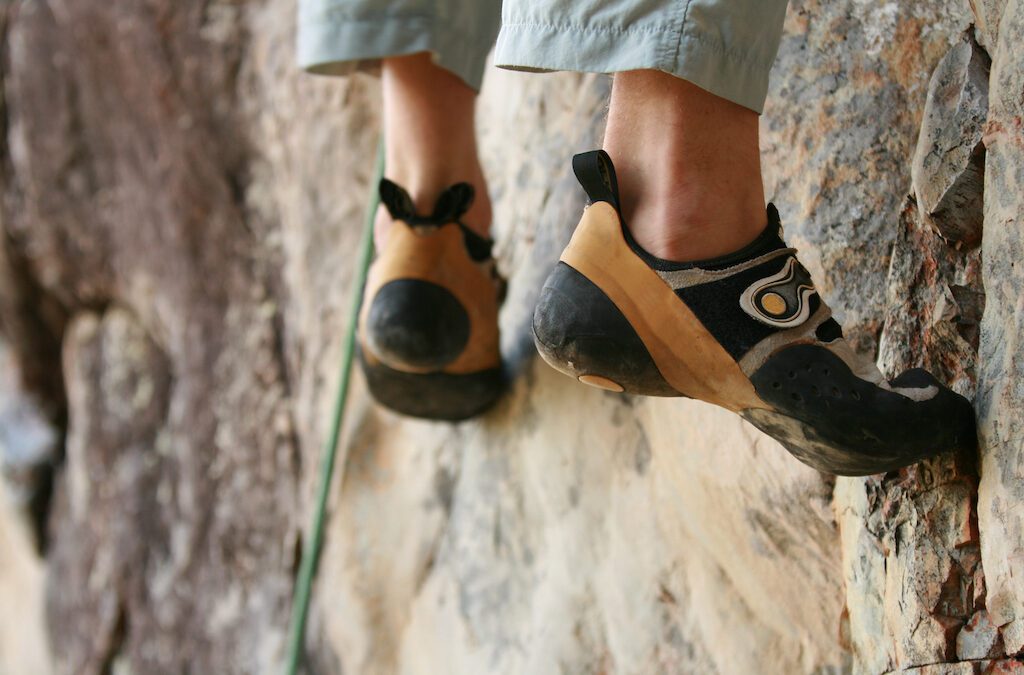Five Fun Drills to Improve Your Climbing Footwork
With these exercises, you'll hone your fancy footwork just in time for the Spring 2023 climbing season

Developing good footwork is essential for progressing as a climber. Strength and power will only take you so far if you don’t have good habits placing and weighting your feet. You’ve probably been developing your finger strength and pull muscles over the past several months in the gym, but how you will fare the next time you have to switch feet while pumped on a lousy, little smedgy foothold outside?
With Spring climbing season about to begin, now is a great time to brush up on your footwork skills. And what better way to do that than with these five drills:
1. Quiet Feet
You can perform this drill on any bouldering or roped climbing wall. The goal is to climb a sequence, problem, or route while placing your feet as quietly as possible. If you find your foot thudding on a hold on a particular move, stop and try it again. Keep working the move until you figure out how you can place your foot with more accuracy and control.
During this exercise, experiment with a wide range of foot placements – inside edge, outside edge, smear, heel hook, toe hook. Focus on placing your feet with intention and driving your weight through the hold in a controlled manner.
2. Eyes on Footholds
We often focus too much on our next handhold, especially while pumped. This drill is great for training the mind to focus on footwork instead. Executing the drill is simple. Climb a boulder or route and intentionally look at each foothold before you place your foot on it. Find the exact spot on the hold where you want your foot to land and then place your foot there. Continue to stare at your foot for two seconds, then continue climbing.
3. Downclimbing
Climbing downwards is surprisingly difficult if don’t have a lot of experience doing it. When you first start exploring downclimbing, you’ll likely find that you put way too much stress on your arms and your feet drop down loudly with little finesse. Downclimbing is an excellent exercise for developing your footwork because it is a foot-first movement. It forces you to think about your foot placements and control your weight with your legs.
The easiest and most natural way to practice downclimbing is to simply incorporate it into your climbing. During your warm-up, downclimb all the boulders or routes you climb. Be thoughtful while climbing down. Try to release as much weight from your arms as possible. Let your feet take the lead and lower your bodyweight down the climb using your legs.
4. Foot Switches
Traverse back and forth on a bouldering wall, switching your feet on a various holds as you move left and right. Aim for 20 footswitches, then take a break. Perform the exercise for at least three to five sets. Start out your switches on larger, easier footholds but as the drill progresses, try switching on worse and worse holds. Try tiny jibs and desperate smears.
There are lots of different foot switching techniques, and each has its own pros and cons. You can hop and swap, for example. This technique is quick and easy, but it’s also not very accurate. While it might be a useful method for moving quickly on easy terrain, it’s not a wise technique to employ on a very poor foothold. A piano switch is another option. In this technique you role one foot off as you roll the other foot on. This again can be tough to execute on tiny holds or smears.
Another technique is the slice, where you bring your unweighted foot down over your weighted foot at an angle. You ‘slice’ your unweighted foot in between the wall and your weighted foot, releasing your weighted foot and transferring pressure onto the new foot quickly.
5. Body Tension Foot Moves
Your feet play a huge role in maintaining body tension, especially on poor holds. Get on an overhanging spray wall, MoonBoard, or Kilter Board. Keep your hands fixed on two holds and then move your feet around to different holds. Try to perform at least 10 foot moves.
Try to incorporate both inside edge and outside edge movements. Try to stand on holds as far away as possible, really requiring body tension and foot pressure. Start out with bigger holds, but as you progress try smaller, slopey holds. Try and perform 3 to 5 sets, taking a rest between each set.
An alternative to this exercise is to instead fix your feet in place on two poor holds and then perform a series of 10 or more hand moves. You might be surprised at how much tension you need to keep through your toes, mid-foot, and calves to maintain pressure on terrible holds on overhanging terrain.




